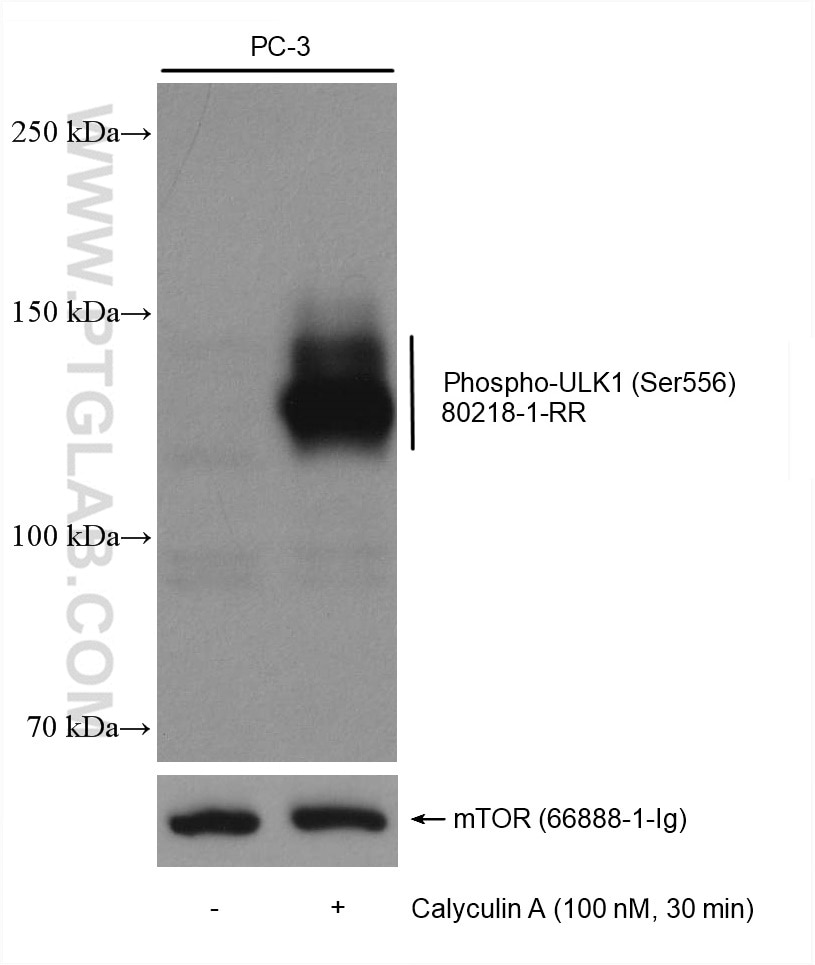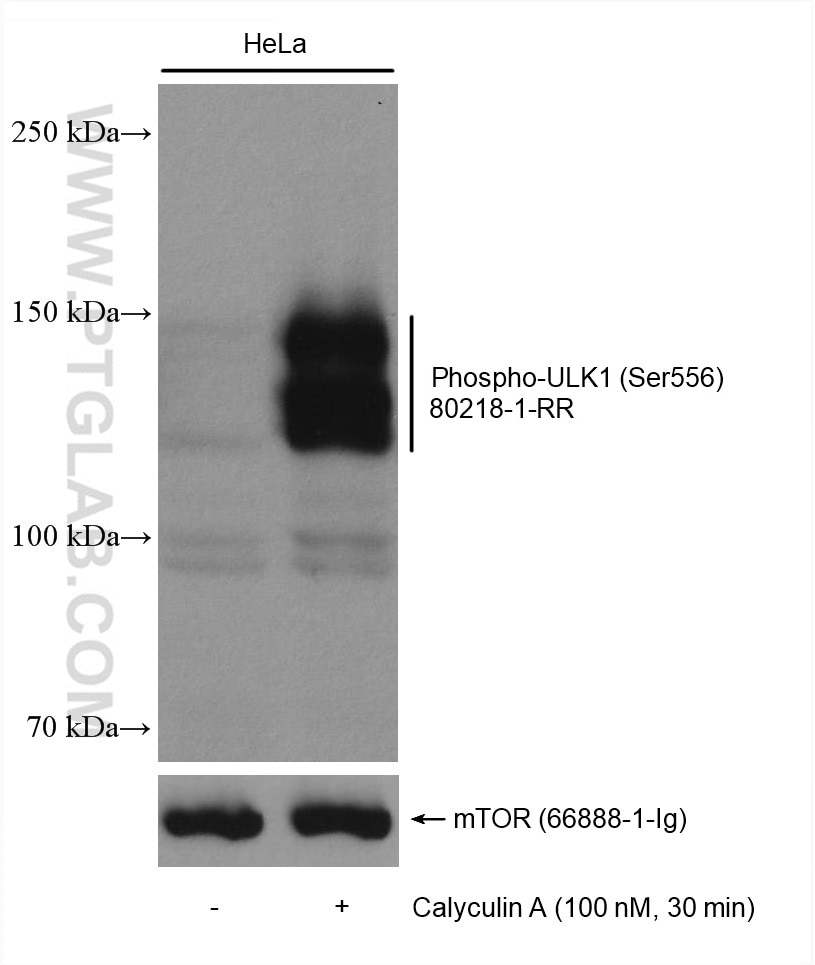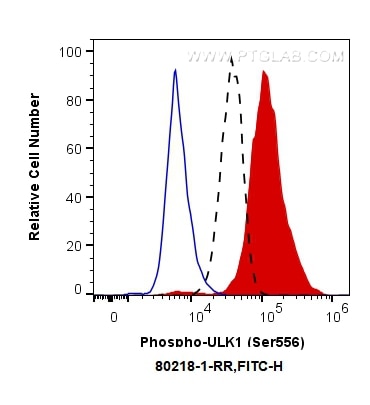Phospho-ULK1 (Ser556) Rekombinanter Antikörper
Phospho-ULK1 (Ser556) Rekombinant Antikörper für FC, WB, ELISA
Wirt / Isotyp
Kaninchen / IgG
Getestete Reaktivität
human, Maus und mehr (2)
Anwendung
WB, IHC, FC, ELISA
Konjugation
Unkonjugiert
CloneNo.
2F5
Kat-Nr. : 80218-1-RR
Synonyme
Galerie der Validierungsdaten
Geprüfte Anwendungen
| Erfolgreiche Detektion in WB | PC-3-Zellen, HeLa-Zellen, Mit Calyculin A behandelte HeLa-Zellen, Mit Calyculin A behandelte PC-3-Zellen |
| Erfolgreiche Detektion in FC | Mit Calyculin A behandelte PC-3-Zellen |
Empfohlene Verdünnung
| Anwendung | Verdünnung |
|---|---|
| Western Blot (WB) | WB : 1:2000-1:10000 |
| Durchflusszytometrie (FC) | FC : 0.50 ug per 10^6 cells in a 100 µl suspension |
| It is recommended that this reagent should be titrated in each testing system to obtain optimal results. | |
| Sample-dependent, check data in validation data gallery | |
Veröffentlichte Anwendungen
| WB | See 11 publications below |
| IHC | See 1 publications below |
Produktinformation
80218-1-RR bindet in WB, IHC, FC, ELISA Phospho-ULK1 (Ser556) und zeigt Reaktivität mit human, Maus
| Getestete Reaktivität | human, Maus |
| In Publikationen genannte Reaktivität | human, Maus, Ratte, Ziege |
| Wirt / Isotyp | Kaninchen / IgG |
| Klonalität | Rekombinant |
| Typ | Antikörper |
| Immunogen | Peptid |
| Vollständiger Name | unc-51-like kinase 1 (C. elegans) |
| Beobachtetes Molekulargewicht | 140 kDa |
| GenBank-Zugangsnummer | NM_003565 |
| Gene symbol | ULK1 |
| Gene ID (NCBI) | 8408 |
| Konjugation | Unkonjugiert |
| Form | Liquid |
| Reinigungsmethode | Protein-A-Reinigung |
| Lagerungspuffer | PBS mit 0.02% Natriumazid und 50% Glycerin pH 7.3. |
| Lagerungsbedingungen | Bei -20°C lagern. Nach dem Versand ein Jahr lang stabil Aliquotieren ist bei -20oC Lagerung nicht notwendig. 20ul Größen enthalten 0,1% BSA. |
Hintergrundinformationen
Unc-51-like-kinase 1 (ULK1) is a target of both the mechanistic target of rapamycin (mTOR) and AMP activated protein kinase (AMPK), whose role is to facilitate the initiation of autophagy in response to starvation. ULK1 is phosphorylated on serine 638 and 758 sites by mTOR in nutrient-rich conditions, inhibiting ULK1 activation by disrupting its binding to AMPK. Upon glucose starvation, dissociation of mTOR from ULK1 and phosphorylation by AMPK leads to the activation of ULK1 activity. The S556 site of ULK1 is one of the major AMPK-dependent phosphorylation sites. (PMID: 30517873, PMID: 21258367)
Protokolle
| Produktspezifische Protokolle | |
|---|---|
| WB protocol for Phospho-ULK1 (Ser556) antibody 80218-1-RR | Protokoll herunterladen |
| Standard-Protokolle | |
|---|---|
| Klicken Sie hier, um unsere Standardprotokolle anzuzeigen |
Publikationen
| Species | Application | Title |
|---|---|---|
J Hazard Mater Graphene oxide disrupted mitochondrial homeostasis through inducing intracellular redox deviation and autophagy-lysosomal network dysfunction in SH-SY5Y cells. | ||
JCI Insight ZNFX1 promotes AMPK-mediated autophagy against Mycobacterium tuberculosis by stabilizing mRNA | ||
Bioengineered Shikonin induces apoptosis and autophagy via downregulation of pyrroline-5-carboxylate reductase1 in hepatocellular carcinoma cells. | ||
Oxid Med Cell Longev tRNA-Derived Fragment tRF-5009A Regulates Autophagy and Degeneration of Cartilage in Osteoarthritis via Targeting mTOR | ||
Cell Death Dis IKCa channels control breast cancer metabolism including AMPK-driven autophagy | ||
Ecotoxicol Environ Saf Role of SESTRIN2/AMPK/ULK1 pathway activation and lysosomes dysfunction in NaAsO2-induced liver injury under oxidative stress |




